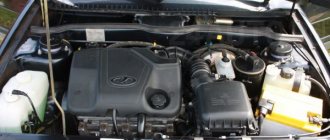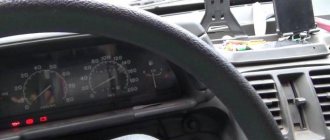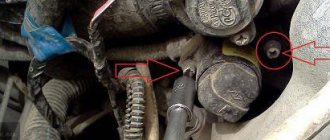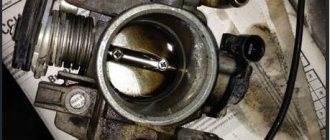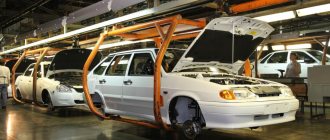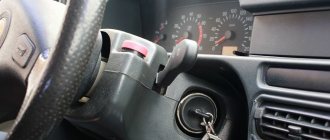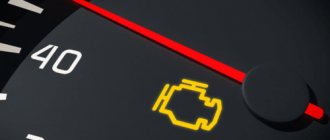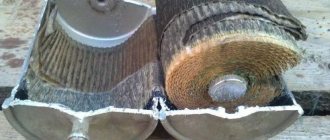Regulator XX
This is one of the fairly common reasons why the VAZ 2114 injector stalls at idle. Regulators called XX or IXX are special devices that help control engine speed at idle. For the power unit to function properly, some air must pass inside. It, in turn, is detected by the mass air flow sensor, and the fuel controller supplies fuel based on sensor readings. Also, the number of revolutions is controlled by the DPKV. But it is the XX regulator that is responsible for the air supply, regardless of the operation of the air valve.
If an IAC system is installed in the car, then, as a rule, the car owner does not need to warm up the engine for a long time before starting to drive. However, this type of regulator is not capable of self-diagnosis. Therefore, if it fails, the VDO VAZ 2114 dashboard does not notify the driver that this unit needs to be checked.
Sensors
In injection versions of VAZ cars, the engine design requires the presence of several important sensors. If the car does not start well when hot, the problem may be in one of the following sensors:
Failure of one of the elements is a problem for the driver. Let's look at the symptoms of malfunction of each of them.
The throttle valve is responsible for the flow of atmospheric air into the cylinder group, from which the fuel mixture is subsequently formed. The throttle position sensor transmits readings to the car's computer, which allows it to maintain stable engine operation.
Self-diagnosis of ICC
To understand that this particular unit is the cause of a stalled engine, it is enough to pay attention to several signs:
- The car's power unit stops working as soon as one of the gears is turned off.
- The revolutions begin to “float”.
- When XX is activated, the motor begins to malfunction.
- As soon as the car owner starts the engine when it is cold, it becomes impossible to increase the speed.
- When the driver turns on the headlights or other light optics, the engine speed begins to drop noticeably.
How to fix the situation
There are several manipulations that will help solve the problem that the VAZ 2114 injector stalls at idle if the IAC is the cause. First of all, you need to disconnect the control unit from the power supply and disconnect the terminal. After this, you need to pay attention to the distance between the flange needles (or rather, their ends) and the regulator. There should be about 2.3 mm between them.
In the next step, the battery terminals are put back into place. After this, you need to turn on the motor for 10 seconds. In this case, automatic calibration of the IAC should occur. If everything is in order, then after this the engine will start normally.
However, this is not the only reason that the VAZ 2114 starts up when cold and stalls almost immediately, or speed jumps occur.
The engine stalls when you press the clutch: why does this happen?
Let us immediately note that if the car stalls when you press the clutch, there can be many reasons for the malfunction. Moreover, in most cases, if you press the clutch pedal a little, then the power unit operates relatively stably. Let's figure it out, focusing on the most common problems.
Let's start with the symptoms. As a rule, many car owners note that cold starts of the engine occur normally, that is, the internal combustion engine starts without obvious problems. However, after warming up a little and starting to drive, the engine stalls when braking, when you press the clutch, etc.
If you monitor the tachometer, the revolutions when you press the clutch drop to such a low value that the engine stalls. By the way, the problem may not appear all the time, that is, it is often a so-called “floating” fault. Drivers also note that a drop in speed can also occur if engine braking occurs, and the clutch pedal is not pressed at this moment.
So, it becomes clear that the car often stalls when you press the clutch at the moment when the gas pedal is released. In other words, the problem occurs in transition mode, when the gas is released and the throttle valve is closed, that is, the idle system is responsible for the operation of the engine.
- First of all, on many cars, similar problems are caused by the failure of the idle speed sensor. Moreover, often after a cold start the car idles normally, but later when driving after squeezing the clutch the speed drops and the engine stops.
If, while coasting, you take your foot off the gas, squeeze the clutch or press the brake, and the speed immediately drops significantly, in most cases this indicates that the XX sensor is faulty and needs to be replaced.
By the way, in order to get to the repair site under your own power, when you come to a complete stop, you may need to constantly press the gas pedal, not allowing the speed to drop. When driving you also need to constantly change the throttle.
First, the driver sharply presses the gas, raising the speed, then quickly depresses the clutch and engages the desired gear. This allows you to change gears before there is a strong drop in speed when you press the clutch.
- Another common cause of malfunction is often the throttle valve. In this case, the problem is due to the fact that the throttle assembly is heavily dirty or damaged.
To fix the problem, it is necessary to clean the throttle valve or replace failed elements. It should be remembered that on many modern cars the throttle body should also be trained after cleaning or other manipulations with the throttle.
- If the throttle assembly is clean and fully operational, then you should pay attention to the throttle position sensor (TPS). This sensor transmits data to the computer about how far the damper is open or closed.
If the readings differ from the actual position of the damper, then the system begins to work incorrectly. In such a situation, it is necessary to check and replace the sensor.
- Provided that no problems are found with the throttle assembly, you should proceed to checking the power system. First of all, it is necessary to assess the condition of the air and fuel filter.
It happens that their severe contamination becomes the reason why in the idle mode there is not enough fuel or air to prepare the “correct” working mixture.
- Then the injection nozzles are checked. Often, dirty injectors can supply an insufficient amount of fuel to the cylinders at different operating modes of the internal combustion engine.
Another element in the power system that needs checking is the fuel pump. If the fuel pump has insufficient performance, the fuel pressure may be low and the power unit will stall at idle and low speeds.
It should also be noted that problems with electrical equipment, airing of the power system, suction of excess air at the inlet, malfunctions of the ignition system, malfunctions of the VUT (vacuum brake booster) and a number of other problems can cause unstable operation of the internal combustion engine. As a result, the engine stalls during transient conditions, at idle, when pressing the clutch or brake, and also during engine braking.
The car stalls when the clutch is depressed: do-it-yourself repair
Idle air control, replacing the IAC idle speed sensor As a rule, some of the problems associated with a stalling engine can be solved independently in a regular garage. The owner of many cars can clean the throttle himself, replace the fuel pump, filters, spark plugs, high-voltage spark plug wires, ECM sensors, etc.
Let's look at the most common operations in relation to gasoline cars. These include replacing the idle speed sensor or IAC (idle speed control). Note that on different cars the installation location of these elements may differ, but the replacement itself is almost identical.
- The first step is to remove the terminals from the battery. Next, it is determined where the XX sensor is located. Then a chip with wires snaps off from it, which is secured with a latch. Next, unscrew the screws securing the regulator from the throttle pipe, after which the element is removed.
- Now the new sensor is put in place. During installation, it is important to ensure that the rubber sealing elements on the sensor (if any) fit tightly to the surfaces.
- Now the sensor, after installation and connection, needs to be calibrated. To do this, you need to connect the terminals to the battery and turn on the ignition for 5-15 seconds. Then the ignition is turned off, after which you can test run the internal combustion engine.
As you can see, no difficulties arise if you need to replace the IAC. The process of cleaning the throttle valve is somewhat more complicated. To complete the task, you first need to purchase a special cleaner (carburetor cleaning liquid is suitable). Next, the throttle assembly is removed (in order to remove the element, separately study the repair manual for a specific car).
After dismantling the unit, the throttle valve and channels should be washed with a cleaning fluid. Please note that you also need to blow out the crankcase ventilation channel (this can be done using a compressor by supplying air under pressure into the channel).
Also, during the process of removing the throttle, you need to carefully inspect the rubber seals of this unit. If the gasket is damaged, deformations, cracks, tears and other defects are noticeable, then the element needs to be replaced.
The throttle position sensor may also need replacement. To replace the TPS, you need to find this element (often it is located on the throttle pipe). The sensor is attached with ordinary screws that can be unscrewed with a screwdriver.
After this, a new sensor is installed in place. Typically, replacing the TPS solves the problem when the car stalls when you press the clutch, when braking the engine, or when you press the brake pedal.
- As for fuel air filters, they also need to be inspected and changed if necessary. Replacing the air filter is not difficult, since you just need to unscrew the cover of the filter housing, remove the old filter element and install a new one. The main thing is to choose the correct size air filter and place it sideways.
When it comes to the fuel filter, you should first locate the fuel pump fuse in the fuse box and turn it off. Then you will need to start the engine. As a result, the fuel pump will not work, the pressure in the power system will drop and the internal combustion engine will soon stall.
Next, you need to find a fuel filter (on different cars it is installed in the engine compartment, in the lower part of the car outside on the bottom, in the area of the gas tank, etc. Often the filter is attached with steel clamps, screwed with screws, etc. Fuel filters are also attached to the filter housing pipes that are removable. Keep in mind that gasoline may leak out of the filter when removed.
When installing a new filter, there should be arrows on the housing that indicate how to correctly position the filter element. The arrows should show the direction of fuel movement from the fuel tank to the engine.
After installing the filter and tightening all the fasteners, turn on the fuel pump by reinstalling the fuse, then you can turn on the ignition for 3-5 seconds so that the fuel pump raises the pressure in the system. After this, the engine can be started.
When the engine is running, you need to again inspect the installation location of the fuel filter. No fuel leaks are allowed at the connection point of the fuel pipes or along the filter housing.
Cleaning the throttle body
First you need to disconnect the clamps that secure the hoses going to the remote control. You will also need to remove the pads from several sensors, or rather, the IAC (if any) and the TPS. After this you need:
- Remove the accelerator cable.
- Remove the throttle assembly itself and assess its condition visually. Such self-diagnosis will help you understand whether the VAZ 2114 injector really stalls at idle due to remote control.
- Disconnect the IAC, which is located inside the throttle.
- Assess whether there is accumulated carbon deposits under the sensor. If it is not in the chamber itself, this does not mean that it is also clean under the regulator. As a rule, all cars with decent mileage accumulate a lot of carbon deposits.
- Clean the IAC needle using a specialized aerosol. You need to process all parts very carefully, and then wipe them dry with a clean cloth. You must act with extreme caution so as not to damage anything. Therefore, it is better if you have a compressor at hand.
If the Lada Samara has low mileage or the sensor has recently been cleaned, then problems may lie in other parts.
VAZ 2114 stalled while driving and will not start
| Rating: 5 456 |
| Reputation: +16 |
Thanked: 29 times Thanked: 59 times
Help me. VAZ 2115, stalled and won’t start!
Post by Dmi » April 14, 2012, 07:58
Messages: 728 Registered: Aug 25, 2007, 00:00 From: YaNAO Purpe Experience: 2006 Car: Nissan Teana :
Awards: 1
| Rating: 928 |
| Reputation: +1 |
Thanked: 6 times Thanked: 1 time
Post by Tyrik » April 14, 2012, 08:37
Messages: 13 Joined: 02 Apr 2012, 00:00
| Rating: 13 |
| Reputation: 0 |
Post by Destro » April 14, 2012, 08:55
Messages: 6 Registered: Dec 23, 2011, 00:00
| Rating: 6 |
| Reputation: 0 |
Post by Tyumen722 » April 14, 2012, 09:52
Messages: 1089 Registered: Apr 02, 2011, 00:00 From: Tyumen Experience: 2000 Car: Top sekret
| Rating: 1 649 |
| Reputation: +2 |
Thanked: 27 times Thanked: 5 times
Post by KRAB72 » April 14, 2012, 09:59
if the sensor the car immediately stalls
Added after 2 minutes 11 seconds:
listen, the fuel pump is not working, or use a tester to check the resistance of the pump itself, look at the + and - taps on it
Messages: 9641 Registered: Jan 21, 2008, 00:00 :
Awards: 1
| Rating: 55 317 |
| Reputation: +93 |
Thanked: 1425 times Thanked: 685 times
Posted by USA » April 14, 2012, 10:17 am
Messages: 118 Registered: May 02, 2011, 00:00 From: Zareka Experience: 2009 Car: VAZ 2107 VAZ 2110
| Rating: 118 |
| Reputation: 0 |
Post by Dj_Prado » Apr 14, 2012, 11:03 am
Messages: 4268 Registered: Jun 06, 2010, 00:00 Auto: V6 3.5 vs 3.0d
| Rating: 9 221 |
| Reputation: +13 |
Thanked: 8 times Thanked: 69 times
Post by Deess » April 14, 2012, 11:07 am
Messages: 992 Registered: Dec 19, 2007, 00:00 From: European district Experience: since 2001 Car: LADA Vesta :
Awards: 1
| Rating: 2 292 |
| Reputation: +8 |
Thanked: 4 times Thanked: 10 times
Post by Steilmann » Apr 14, 2012 11:15 am
Messages: 118 Registered: May 02, 2011, 00:00 From: Zareka Experience: 2009 Car: VAZ 2107 VAZ 2110
| Rating: 118 |
| Reputation: 0 |
Post by Dj_Prado » April 14, 2012, 11:19
Messages: 500 Registered: Oct 24, 2011, 00:00 From: Tyumen Experience: 2011 Car: Lancer X
| Rating: 740 |
| Reputation: +1 |
Thanked: 3 times Thanked: 1 time
Post by Pioneer172 » April 14, 2012, 11:31 am
Messages: 685 Registered: August 31, 2011, 00:00 From: TYUMEN Car: VAZ-2114
| Rating: 1 447 |
| Reputation: +3 |
Thanked: 56 times Thanked: 9 times
Post by DREDD » April 14, 2012, 01:27 pm
| Rating: 5 456 |
| Reputation: +16 |
Thanked: 29 times Thanked: 59 times
Post by Dmi » April 14, 2012, 4:17 pm
Messages: 6 Registered: Dec 23, 2011, 00:00
| Rating: 6 |
| Reputation: 0 |
Post by Tyumen722 » April 14, 2012, 6:54 pm
| Rating: 5 456 |
| Reputation: +16 |
Thanked: 29 times Thanked: 59 times
Post by Dmi » April 14, 2012, 21:03
In general, the thing is this: there is a spark, the spark plugs are dry, the sting is red (if that’s what the thread is talking about), there’s a buzz in the ramp, but not much (there’s no gauge), the pump is humming. I don’t know what to do at all(((
Added after 4 minutes 1 second:
and also, when I removed the timing case, somewhere between the gears, the roller and the pump there was a little smoke coming out, an exhaust. related somehow?
Air filter
If all the reasons described above do not apply, then you should pay attention to the filtration system. This unit also often leads to malfunctions.
On injection-type cars, filters are adjusted to an optimal and universal operating mode. This element is necessary in order to trap dust and dirt, but not impede the passage of clean air. Typically, small panel filters are installed in VAZs. They are considered more efficient and compact. However, cylindrical models are often installed in cars, which quite quickly cease to perform the task correctly. In this case, you will need a simple diagnosis of the VAZ 2114 car and replacement of the damaged element.
The first problem is that the starter turns, but does not engage
Let's consider the following situation when the VAZ-2114 does not start, but the starter continues to turn. You should also take into account the nuance that the starter still does not engage. The mechanism of the problem is as follows:
- the key is inserted into the ignition;
- the fuel pump pumped up the fuel mixture;
- during the ignition startup process, the starter turns in idle mode (experts call this process “the starter does not catch”).
Experienced motorists note that a similar situation occurs in VAZs with high mileage, so we can talk about wear of either the starter itself or its parts. So, most often the overrunning clutch or “Bendix” suffers; the main element here is the gear. It is this overrunning clutch gear that causes a lot of trouble, because its teeth are often subject to wear. The mechanism of the malfunction appears as follows:
- the driver turns the key;
- the starter starts to spin;
- The overrunning clutch gear cannot engage the engine due to tooth wear.
Even in the starter, its gearbox may fail. This problem is less common than the previous one. This gearbox includes several types of gears, which are also subject to wear due to the long life of the vehicle. There are five gears in total:
- one small;
- three satellite gears;
- one large one, attached directly to the gearbox housing and engaged with the satellites.
Repair
For self-diagnosis and repair, the air filter must be removed. It is not so difficult to do this on injection-type cars. To do this, you need to open the hood of the Lada Samara and disconnect the DRV.
After this, all that remains is to find the screws (usually there are four of them) that secure the filter and remove them using a shaped screwdriver. After this, you can easily remove the filter. At the next stage, all that remains is to assess how dirty it is and, if necessary, replace this element.
Fuel filter
This element acts as a fuel purifier that enters the engine. If the fuel mixture contains a large amount of dirt, various impurities and particles that should not enter the power unit, this can cause many problems.
If the fuel channel begins to become clogged, the XX sensor will not be able to work correctly. Therefore, this will lead to the VAZ 2114 injector stalling when cold. If the problem is not corrected, the situation may only get worse.
Replacing the fuel filter yourself
Before performing work, it is necessary to drive the car onto an overpass or pit. After this, you need to find the necessary filter. In this car model, it is located under the bottom of the vehicle behind the fuel tank, next to the muffler. After this, you should unscrew several fittings (pipes). It is best to do this using key number 19 M.
If everything is done correctly, the filter can be easily removed. You just need to remember which side it was installed on. After this, it is enough to put the new filter in the same place in the correct position.
If the VAZ 2114 stalls, there may be other reasons. Therefore, it is worth considering them in more detail.
Injection system
If you contact a specialized service center, specialists will definitely check this unit for serviceability. Therefore, when self-diagnosis, this is also taken into account. Often errors in the operation of the power unit are associated with hydraulics. Some of its parts may work correctly, but if the so-called coking of the injectors occurs, then problems cannot be avoided. As a rule, the cause of this phenomenon is low quality fuel. If it contains impurities that cannot dissolve, then all these particles begin to settle on the injection elements. In the first few minutes of engine operation, this problem becomes most obvious.
Other reasons
First of all, you need to understand that a lot depends on how cold it is outside. If there is severe frost, it is not surprising that an unheated engine will malfunction. Therefore, you have to constantly keep your foot on the gas pedal.
Sometimes the problems are related to the spark plugs. Therefore, it is recommended to check them. You need to understand that these elements do not have a long service life. Therefore, if the car has quite an impressive mileage, then perhaps it is the spark plugs that have become unusable. Soot may settle on them. This often leads to irreversible damage to the elements.
If problems arise specifically with the spark plugs, then you need to find the damaged one and replace it. To do this, it is not necessary to seek help from a specialized center. All necessary work can be done independently.
Problems with engine activation can also arise due to problems in the ECU. It is also worth checking the quality of all connections. There is a risk that the wiring of the VAZ 2114 injector has been damaged. Therefore, it is worth making sure that it is in good working order.
It is also recommended to pay attention to the vehicle's exhaust gas recirculation valve. In this case, a cold engine will stall. To correct the situation, it is enough to replace the faulty unit.
Stalls on a hot VAZ 21099, injector
VAZ 21099i, when heated to t=95, stalls and does not start until it cools down almost completely. At the same time, I found out that there was no spark and there was no voltage going to the injectors. The starter turns normally. What could be the reason?
- VAZ Samara starter will not start - 5 answers
- I can’t start the VAZ 21099 from the starter – 5 answers
- A hot VAZ 21099 has trouble starting - 4 answers
- Stalls while driving 21099 – 4 answers
- VAZ 21099 car will not start - 3 answers
Is there no control voltage on the injectors or a common +12? The main relay turns on when the ignition is turned on, does the fuel pump work?
The ignition module is faulty, it overheats and fails, if the 2112 module is an old model, they are very sensitive to voltage drops.
The voltage at the injectors must be measured relative to the ground, they have a total of +12 volts, and the control voltage comes from the ECU (the minus comes from the ECU). On the ignition module + 12 is also relative to ground.
Does the pump run as usual for 3-4 seconds and turn off? First, check all the masses on the body and engine, not only those under the hood, but also those in the cabin. Second, check the connector on the crankshaft sensor, and the sensor itself (the method is described on the internet). If there is no signal from the dpkv, the computer will not send a signal to either the injectors or the ignition module.
Of course it could fly out, but then why does the spark disappear? It seems to me that there is some kind of general problem, for example, voltage loss. Have you checked the presence of voltage +12 relative to ground, where I described above? You also need to check the supply voltage to the ECU, one goes to it constantly from the battery, the other after turning the key. So far I can’t even connect this with the temperature, but if the ignition module is faulty, try unscrewing it from the engine, it’s possible that the problem will appear sooner or later.
I don't quite understand where you measured. You need to measure between the first and fourth and between the second and third terminals on the spark plugs. That is, the windings are 1-4 and 2-3. I won’t tell you the size, just a few kilo-ohms.
There must be megohms between the windings, that is, if the probes are placed at 1 and 2-3, or for example, 2 and 1-4, the resistance should be very high.
But all these measurements are relative, you cannot determine the turn circuit, a cold winding can show one thing, but a hot winding can go wrong.
As for the module input, I don’t know how to diagnose it with an ohmmeter, there is an electronic circuit inside the module and the ohmmeter doesn’t work.
I don’t remember what the symptoms were, but on the two-wheeler I installed an insulator between the engine and the module, and I transferred the heat from the module to an aluminum plate. I can attach a photo later if interested.
Before this, I replaced two modules, which apparently failed due to overheating. Although the plate also heats up, the hand holds it calmly, unlike the heated engine. That’s why I wrote to you above, try to move the module away from the engine so that it doesn’t heat up.
Solved the problem! It was in vain that I paid attention to the previously stripped insulation on the wires going to the injectors; I thought that due to their contact with each other, the ECU was damaged and therefore the spark disappeared even when heating. It turned out that the ignition module was at fault.
I do not agree that measuring at the input terminals does not make sense; it is the RESISTANCE OF THESE OUTPUT THAT PROVIDES INFORMATION TO THE ECU ABOUT THE SERVICEABILITY OR MALFUNCTION OF THE MODULE.
I repeat once again that the resistance on two showed a little more than 17 kOhm (if you look from above, these are the first two on the left), and on the new module the resistance is more than 2 mOhm.
When heated to a certain temperature, the input resistance of the module dropped to a certain value, at which the ECU concluded that the module circuit was short-circuited and turned off the supply of control voltage to it and to the injectors, apparently to prevent gasoline vapors from accumulating in the muffler.
Replaced the ignition module, drove it for two days, started without problems! Thanks to everyone who responded, your advice helped me find a solution to my problem!
Diagnostic features
It is worth considering that there are no exact sequential actions by performing which it will be possible to accurately determine the cause of the malfunction. If the power unit stalls only occasionally, then the situation may not be that serious. There is a chance that this is how the vehicle simply reacts to severe frosts. However, if you have recurring problems, you should contact a specialist.
It is best if the mechanic connects a specialized diagnostic device to the car at a car service center. He will determine exactly where the breakdown occurred and which element should be replaced. Of course, if the car owner has enough knowledge, he can identify the problem on his own. But you need to understand that if such a diagnosis was performed incorrectly, this can lead to more serious consequences. In this case, the final repair of the car will be much more expensive. Therefore, you should think several times before saving.
The “fourteenth” model from the domestic automaker AvtoVAZ gained enormous popularity in its time due to its reliability, workmanship, responsiveness and agility of the power unit.
Of course, this car cannot be called ideal. Therefore, problems may arise from time to time. It is not uncommon for the rpm to fluctuate at idle. Such phenomena irritate the driver and lead to unpleasant scenarios on the road. For example, at any moment the engine may simply stall.
It is unlikely that you will be able to solve the problem for a long time by pressing the accelerator pedal in order to maintain speed. Therefore, more drastic actions need to be taken.
see also
Comments 23
Of course, just put the belt and all the marks! Do you know where the marks are? Well, take a look at the tension roller, making sure it doesn’t play! Write if you have anything!
First, look at the spark and then ask a question, maybe the wiring to the crankshaft sensor is trivial.
But the signaling cannot show off. I've already had something like this happen, it glitched and the f*ck wouldn't start.
There was no metallic sound when you stalled? looks like a belt
There are no teeth on the belt, is it possible to just change the belt itself or does it have to be all together?
Well, usually they change the belt + rollers as a set. I honestly don’t know about just the belt.
timing belt, something similar happened in the summer, remove the cover and maybe you’ll see something else...
There are no teeth on the belt, about 6 in a row and 2 in another place
timing belt, something similar happened in the summer, remove the cover and maybe you’ll see something else...
Another question is whether it’s possible to just change the belt itself or whether everything needs to be changed there, it’s just that the budget is tight
Look at the crankshaft sensor chip itself and the key on the pulley, I had the same thing last winter
Look at the spark! I had a similar situation, the ignition module burned out!
This is one of the main reasons, it may not be in place... you need to make sure that the teeth on the belt are in place or the key on the pulley has been cut off! Actually, look!
thanks, I'll take a look tomorrow
This is one of the main reasons, it may not be in place... you need to make sure that the teeth on the belt are in place or the key on the pulley has been cut off! Actually, look!
There are 6 teeth on one side and 2 on the other, can you just change the belt itself or is it necessary to change everything together?
Usually the belt with rollers (included) is changed and you need to look at it over time, whether it has worn out or something helped it (maybe the pump is jammed), my problem turned out to be in a small sprocket... I was driving along the highway... there was a heavy truck ahead, I slowed down and was coasting and I need to I was about to add gas, but the engine didn’t work... okay, downhill, I pulled off safely to the side of the road... they dragged me to the city service center on a rope... I had this belt for a year
I think it's worn out; I haven't replaced it even once in 1.5 years of ownership.
maybe from time to time... the first time it was torn in my city too, and like you probably didn’t have 10 cm teeth, the service center immediately told me, rollers, belt, pump - change everything together, if they got into it (16 valve 2011 -it’s problematic to change, and even during the first year I went there, in my opinion, they never climbed there), I changed everything, and a little over a year later again, but the asterisk turned out to be to blame...
How does this happen
If the car is running normally, all you need to do is start it and wait until the engine warms up to the optimal temperature. The tachometer indicator at this moment is at 2-2.5 thousand rpm, and then gradually drops to about 800 rpm as the power unit warms up.
But when there are problems, the idle speed jumps and changes sharply. The range of revolutions difference on the tachometer can be significant, up to 1.5 thousand revolutions. The car seems to live its own life. After some time, this phenomenon stops. But the next time the ignition is turned on, everything repeats.
Broken idle air control
If the load on the power unit sharply decreases when the movement is slowed down by sudden braking, the machine begins to turn on the pre-idle mode. Then, according to the norm, the sensor should turn on automatically. He is responsible for controlling engine speed. If the sensor is faulty, this leads to the fact that the engine simply does not have time to switch to idle.
The engine speed begins to drop, and then it stops functioning altogether.
A car enthusiast can detect poor engine operation if he concentrates his attention on floating idle speed. Their manifestation is implicit if you sharply press and then release the brakes. This problem occurs quite often
To check the operation of the sensor you will need a multimeter. If this tool is not available, then you will not be able to measure the voltage. Therefore, it is advisable to always have it in your car. In this case, the power supply must be disconnected from the sensor.
This problem occurs quite often. To check the operation of the sensor you will need a multimeter. If this tool is not available, then you will not be able to measure the voltage. Therefore, it is advisable to always have it in your car. In this case, the power supply must be disconnected from the sensor.
It is necessary to insert the first probe into the hole of terminals A and D. In this case, the second probe must touch the body. After this you will need to turn on the engine. Next, you should look at the meter readings. The voltage on it should show 12 V. This indicator may be slightly higher, but not significantly. If the measuring device display does not show anything, then it is advisable to check the wires or circuit completely.
If the indicator is within 12 V, we continue to carry out diagnostic procedures. We do not turn off the engine and continue to measure the resistance. Only outputs A and B, C and D are of interest. If the voltage is, for example, for a VAZ 2109 530 m, then this indicator is considered good. On the contrary, if the motorist saw other data, the sensor will have to be cleaned or replaced.
Causes
The most dangerous thing in this case is inaction. Today we will talk about why the idle speed on the VAZ 2114 jumps, what are the reasons and what actions should be taken in this or that situation.
In fact, the reasons can be very different, so we will try to comprehensively study this issue.
Electronic control unit
It is not uncommon that the electronic brains of the VAZ 2114 car become the source of all problems associated with idle floating speed. If a sensor fails, this affects the ECU receiving incorrect information. Consequently, the engine does not operate at the parameters it needs.
Floating speed on the carburetor
On carburetor versions of the VAZ 2114 there is no electronic control unit as such. But this does not mean at all that the problem of floating speed is not alien to him.
Tachometer with high speed
Floating speeds do not occur as often as in the case of an injector, but still. The reasons, as well as troubleshooting methods, vary.
- The idle speed is set incorrectly, or it got lost during operation. In such a situation, the setting shifts to combining the fuel-air mixture. Here you will need to adjust the speed to the range of 800-900 units.
- The solenoid valve is faulty. The engine will only run if the choke is pulled out. If you remove it, the engine will immediately stall.
- The idle jet or channels are dirty. In such a situation, the fuel lacks air. Clean the jet and the problem will go away.
- Excessive air is sucked in. The mixture becomes leaner, so the engine sputters and stalls.
- The level of gasoline in the float chamber increases or decreases.
- The air filter is clogged. The problem is solved by simply replacing the element.
If engine vibration occurs at idle speed of the VAZ 2114, there is no need to worry. It's all about the design of the engine. A similar phenomenon is typical for carburetor engines during cold starts. The engine just needs to warm up to the optimal temperature, after which the vibrations disappear.
The reason for the vibrations is the air-fuel mixture , which is prepared by the carburetor before being fed into the combustion chamber. Low temperatures lead to inefficient combustion of the mixture. Hence the “shaking”.
Although it is not uncommon for vibrations to occur due to the cushions, that is, the engine mounts on which it is mounted. When they wear out, vibrations are possible. Moreover, this does not depend on what type of engine is used - injection or carburetor.
You should always pay attention to the floating speed of the VAZ 2114 and not wait for the problem to manifest itself in some other way. If you delay in identifying the causes and eliminating faults, repairs can be much more expensive.
Fuel supply faults
It is quite easy to find out that the car stalls while driving due to the engine being “choked” with the fuel mixture - during a long drive you will find that the signal of the sensor responsible for this function is constantly on.
Here the problem lies in low-quality fuel, which does not quickly “ignite” from the spark of the candles. It can also be caused by gasoline not meeting the requirements for the octane number specified in the vehicle specifications. If there are problems with fuel, the gas pedal will be pressed all the way, and the car will not begin to gain speed. In addition, the car will periodically stall when the clutch is engaged.
Another symptom indicating problems with fuel is the appearance of problems with the car after refueling. The problem is characterized by a rapid drop in engine power at full speed, as well as when constantly changing gears. The way out of the situation is to completely drain the bad fuel mixture, wash the engine and all the fuel system pipes.
Also, the car will constantly stall if there is an interruption in the supply of the fuel mixture. This may be due to contamination in the following system components:
- Dirt in the fuel filter;
- Problems with injector nozzles;
- Dirty throttle valves;
- Fuel pump power failure.
The main symptom of a malfunction of these parts is that there will be a gradual drop in the power of the car’s engine, after which the car will stall even after sharply pressing the gas pedal. If you do not release the clutch carefully when changing gears, this will also cause the engine to stall.
The contamination of the fuel filter and fuel pump can be judged by the unstable operation of the machine even during idling and during rapid braking (when the supply of the fuel mixture decreases). And if the performance of fuel filters can be easily established during an external inspection and eliminated by replacing them, then to detect other causes, you need a full-fledged computer diagnostics, which can only be carried out in a car service center.
Another reason for a stalled car associated with the operation of the fuel pump is boiling gasoline in the fuel pump. This happens mainly in hot weather when the car is moving slowly or standing on the highway in traffic jams. The car will start to stall while driving, but when you turn on the idle speed and press the clutch, it will start again.
If boiling occurs, it is better to stand in a traffic jam with the engine turned off and gradually cool the car. After 5-10 minutes, the car's operation will be stable again.
Advice: if you recently did a wheel alignment with your own hands on a VAZ-2107, then to cool the car, proceed as follows - throw a piece of cloth made of dense material over the fuel pump body, which you first moisten with cold water.
